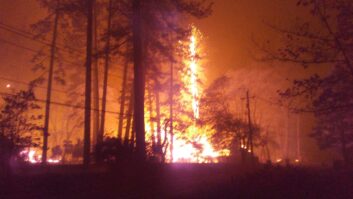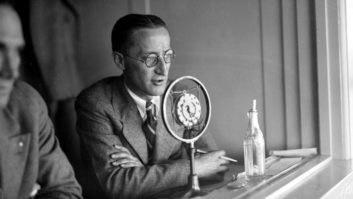Red River Radio
Sep 1, 2013 7:15 AM, By Kermit Poling
Red River Radio’s move to new studios was long overdue. Housed for 28 years in “temporary” buildings that were installed on the Louisiana State University Shreveport campus in 1964 (originally as the campus snack shop), our public radio network needed a new home. Flagship station KDAQ went on the air in Shreveport in 1984 with three repeater stations and a translator added over the next few years. As the NPR affiliate for Northwest and Central Louisiana, South Arkansas and East Texas, geographically we are one of the largest public radio networks in the system.

The metal buildings were in poor condition, a rat’s nest of patchwork repairs behind racks was a confusing mess, and even the custom-built Ward Beck console in the MCR had been so cannibalized over the years that there were few cures left for any new problems. (Open slots in the mainframe did leave a convenient space to warm one’s hand on a cold day or to provide shock therapy as needed.) With the studios and offices in different buildings, work flow and communication were complicated, especially on a rainy day!
Feasibility studies confirmed that the best solution was a new home. Plans were initiated to build a new facility from the ground up. Priorities included more space, more production capability and routing to better accommodate all of our audio streams including our main channel, HD2, HD3 and the Internet. Ease of use was also important so that talent would have an easy transition. Another obvious requirement was that the new facility should house the studios and offices under one roof. We also wanted an attractive facility that would be inviting during special events.
A new feature
A major focal point was the addition of a performance studio for live music events. Our line-up includes a wide variety of music – classical, jazz, blues – alongside regional and national news. Over the years, bands had often performed live in the tiny lobby of the old studios, spreading out in front of the drink machines across from the MCR. Hardly an ideal situation! On a stormy day, the raindrops on the metal roof overpowered anything going on in the studios, including the announcers. Fortunately that was coming to an end.

The production studio
About two years into the planning, an old church building that had been annexed by our university became available. This building had served not only as a church, but also as a student union, offices and classrooms. Remodeling and restoring this building would be a challenge but also save us more than a million dollars from the original estimates. We jumped at the chance. Architect Mark Prevot of Prevot Design Services was engaged to deliver a workable concept. The LSUS facilities director, Don Bloxom, would oversee construction progress on our end. Mark Wilson was our consulting broadcast engineer.
The building was an A-frame design built in the 50s. The original raised brick altar area still existed and it was tempting to keep this somehow for the new control room, but ADA compliance issues forced us to bring everything down to the same level. Nevertheless, the MCR could occupy this place of honor, looking out into the middle of the building, which would become the performance studio.
We wanted to take advantage of the high ceiling in the middle of the building. We hoped it would provide visual beauty in the performance studio and felt we could bring the space under control with proper acoustic treatments. The original ceiling was hidden by the drop ceilings that had been in place for decades; we didn’t know what we would find above them. We hoped that we wouldn’t run across any serious obstacles.
– continued on page 2
Red River Radio
Sep 1, 2013 7:15 AM, By Kermit Poling
See-through studios
One important visual design aspect of the new performance studio is a large glass wall on the lobby side. Besides catching the attention of those walking into our building, it allows anyone in the control room to look straight through the performance studio to see anyone at the front door, a fringe benefit. The design included non-parallel side walls and the big glass wall is broken up by perpendicular segments. On the MCR side, the windows were all angled and large acoustic insulating doors were installed. (The doors had to be wide enough to easily allow for large musical instruments). In addition, 48 custom designed, locally built absorbing panels contribute to give us a warm sounding, flexible studio. The studio is large enough to accommodate performers and a small audience of about 40-50 people.
We wanted to be as “green” as possible, so all new lighting is LED and the floor is made from reclaimed wood in the performance studio and lobby areas. (The MCR, Production 1 and the Newsroom have carpeting.) Extra care was given to the air conditioning to assure that it was efficient and that there was no noise introduced from the ductwork into the studios. The offices and production studios are on opposite sides of the building, providing additional isolation from office sounds.

Looking through the great glass wall into the performance studio
Early on we decided to use an audio over IP system. CAT-6 cables made interconnection a simple matter. We chose the Axia IQ system for several reasons. NPR -and the PRSS- was upgrading to new receivers built by International Datacasting. These included Livewire so it seemed logical to use Livewire elsewhere. Also, the Axia IQ control surfaces are easy to configure and understand. We do a lot of call-in programs so high quality phone hybrids were essential. We chose Telos IQ6 digital hybrids, which integrate seamlessly with the IQ consoles and Livewire.
The MCR has an additional mixing station connected to the performance studio. A Presonus digital console feeds both Livewire and a recording computer running several programs including ProTools and Sound Forge. Audio files are stored primarily on Glyph drives in the engineering racks for access throughout the facility. The Presonus also mixes live in-studio sound both for audiences and for the performers’ monitors.
The MCR and Production both accommodate the board op/host and three guests. Sennheiser mics, primarily MD-421, are at all stations. Local sources include Tascam CD players, legacy DAT machines and a turntable in the control room. (A lot of those old jazz recordings are still on LP.) We also kept two of our Otari half-track analog machines so that old archival recordings of the symphony, opera, etc., could be transcribed and converted to digital at some point.

The performance studio provides a large, open space. Photo by Neil Johnson
WireReady’s ControlReady automation had worked very well for us over many years. The old studios ran an old version on computers running Win2000 so upgrading to the latest version on “modern” computers was a no-brainer. One of WireReady’s strongest benefits is very reliable walk-away background automation which we use extensively especially on HD2 and HD3.
Several of the IQ features were not yet enabled by Axia in their software. Time being of the essence, we opted to use Broadcast Tools AES switchers. Eventually we will use Axia’s Pathfinder software to handle the routing duties. Commands can be either automated or manually activated. Any of the studios can be used on-air on any of the audio streams or all of them at once, useful during fundraising pledge drives.
– continued on page 3
Red River Radio
Sep 1, 2013 7:15 AM, By Kermit Poling
Protected studio circuits have both battery backups and an Eaton generator with an automatic transfer switch to keep us on the air in bad weather. Multiple data networks were set up for Axia, Internet and phones. One surprise – the electrical contractor had wired about half of these incorrectly and then didn’t mark the terminations back in the engineering rooms. We ended up with a lot of unexpected toning and replacing of connections.

The mixing station
Red River Radio not only uses a satellite downlink for network programming, but we also use the same dish as an uplink to the PRSS which serves as our STL to our transmitter sites. This enabled us to decommission all of our microwave hops while at the same time maintaining an extremely reliable relay of programming. Radyne DMD20s at all sites effectively create our own private data network from ground to satellite to ground.
Audio processing is accomplished with Omnia units. We have an ample number of Axia nodes for interconnecting devices and these ultimately send AES audio to the Omnias. From the Omnia processors audio data goes to our Harris Importer and Exporter and then out to the satellite system.

The performance studio provides ample space for performers and audience.
In the short time we have been in our new studios we have received many compliments on our improved sound and have had very few technical glitches, at least those of the kind that can be heard by our audience. We’ve already held a half-dozen live music events and these have validated the extra trouble we went thru for the performance studio. The long hallways on either side of the performance studio have been turned into galleries for visual artworks, which are changed quarterly. In short, our goal of creating a versatile facility to provide excellent audio, more production capacity and ease of use while being visually attractive for the community has been well accomplished.
Partial Equipment List
Adobe Audition
Axia AES/EBU nodes, GPIO nodes, IQ, Pathfinder
Broadcast Tools DAS 8.4 Plus
Cisco Catalyst
Glyph hard drives
International Datacasting SPX4101
Lynx AES3 audio cards
M-audio BX8
Mackie MCU Pro
Omnia 1, Omnia 6
Presonus Studiolive 24.4.2
ProTools 10
Radyne DMD20
Sage Digital Endec
Samson Servo 1200
Sennheiser MD 421
Sound Forge 10
Tascam CD-500B
Telos IQ6
WireReady ControlReady software
Various mics from AKG, Shure, Neumann
Poling is general manager of Red River Radio, Shreveport, LA.
September 2013
Digital test devices, Red River Radio rebuilds, vertical radiators explained, Field Report on the Tieline Merlin Plus, Z100 celebrates 30 years and more….











